Physical Science 8 Assignment: Multiple Physics Problems
VerifiedAdded on 2022/09/10
|8
|1684
|22
Homework Assignment
AI Summary
This document provides a comprehensive solution to a Physical Science 8 physics assignment. The assignment covers a range of physics concepts, including multiple-choice questions, true/false statements, fill-in-the-blank exercises, and matching questions. The document also includes detailed solutions to problem-solving questions, such as distinguishing between scalar and vector quantities, distance and displacement, and calculating acceleration and centripetal acceleration. The solutions show the application of physics principles and formulas to solve the problems and arrive at the correct answers. Moreover, it includes references to cited sources, which are critical to the assignment. This assignment is a great resource for students studying physics, offering a complete guide to the concepts and problems covered in the course.
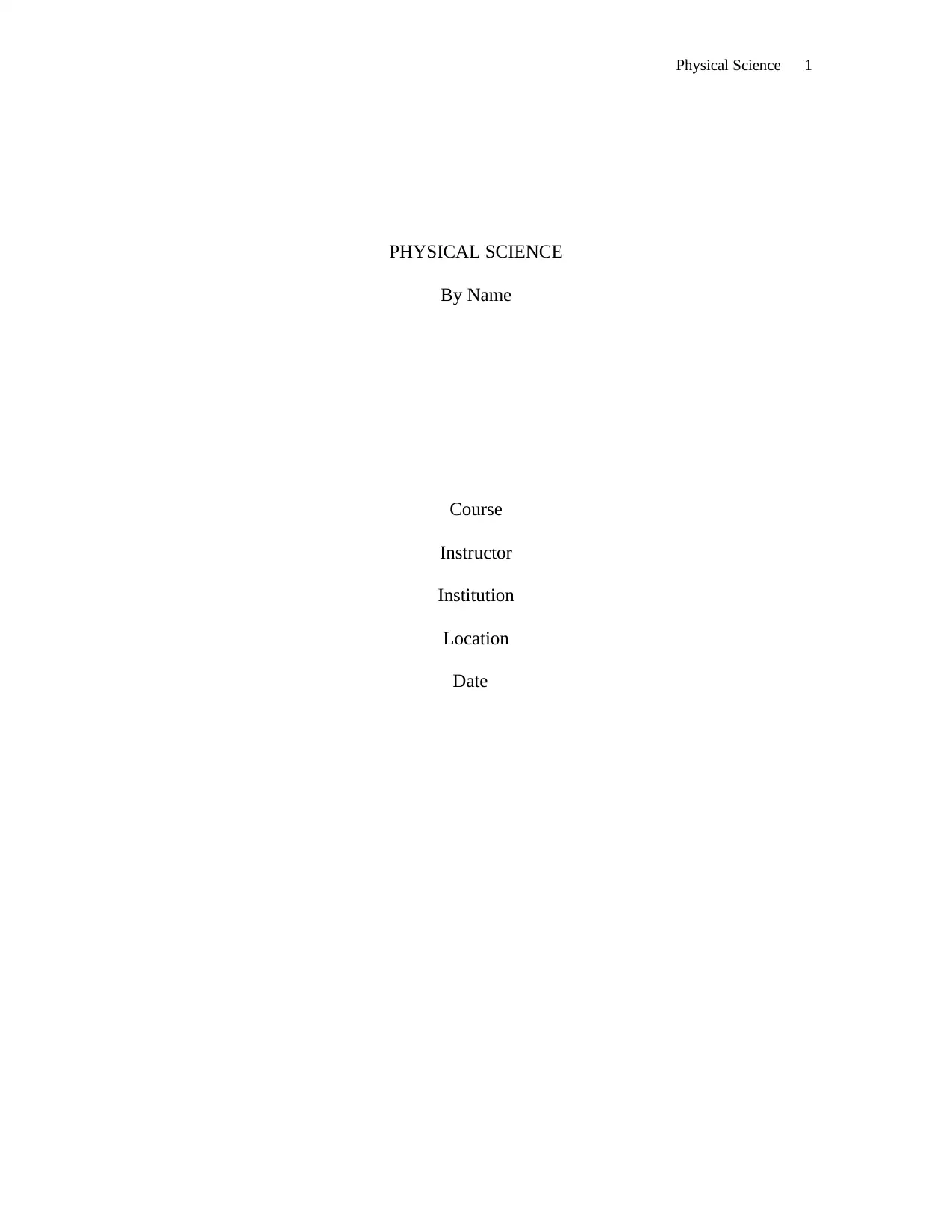
Physical Science 1
PHYSICAL SCIENCE
By Name
Course
Instructor
Institution
Location
Date
PHYSICAL SCIENCE
By Name
Course
Instructor
Institution
Location
Date
Paraphrase This Document
Need a fresh take? Get an instant paraphrase of this document with our AI Paraphraser
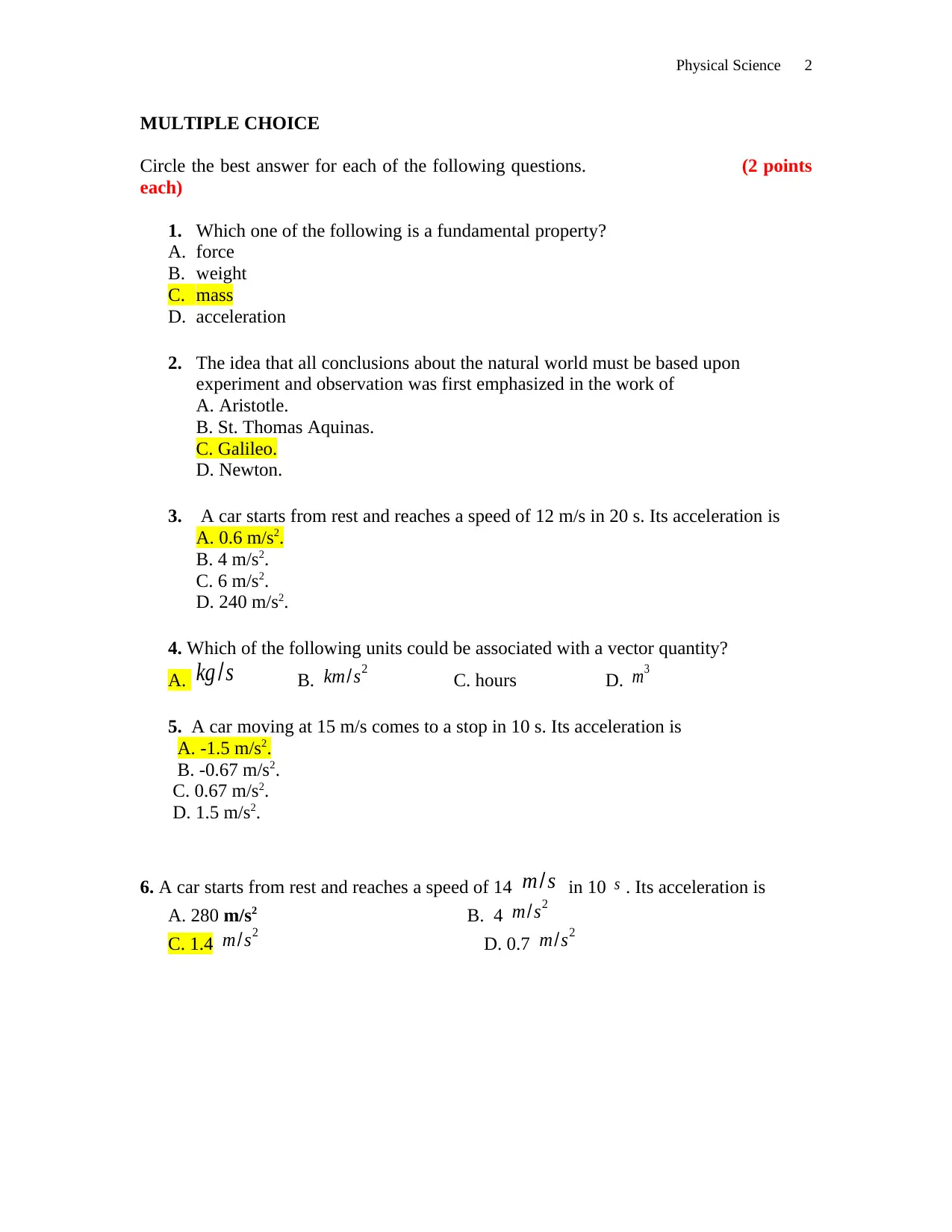
Physical Science 2
MULTIPLE CHOICE
Circle the best answer for each of the following questions. (2 points
each)
1. Which one of the following is a fundamental property?
A. force
B. weight
C. mass
D. acceleration
2. The idea that all conclusions about the natural world must be based upon
experiment and observation was first emphasized in the work of
A. Aristotle.
B. St. Thomas Aquinas.
C. Galileo.
D. Newton.
3. A car starts from rest and reaches a speed of 12 m/s in 20 s. Its acceleration is
A. 0.6 m/s2.
B. 4 m/s2.
C. 6 m/s2.
D. 240 m/s2.
4. Which of the following units could be associated with a vector quantity?
A. kg /s B. km/s2
C. hours D. m3
5. A car moving at 15 m/s comes to a stop in 10 s. Its acceleration is
A. -1.5 m/s2.
B. -0.67 m/s2.
C. 0.67 m/s2.
D. 1.5 m/s2.
6. A car starts from rest and reaches a speed of 14 m /s in 10 s . Its acceleration is
A. 280 m/s2 B. 4 m/s2
C. 1.4 m/s2
D. 0.7 m/s2
MULTIPLE CHOICE
Circle the best answer for each of the following questions. (2 points
each)
1. Which one of the following is a fundamental property?
A. force
B. weight
C. mass
D. acceleration
2. The idea that all conclusions about the natural world must be based upon
experiment and observation was first emphasized in the work of
A. Aristotle.
B. St. Thomas Aquinas.
C. Galileo.
D. Newton.
3. A car starts from rest and reaches a speed of 12 m/s in 20 s. Its acceleration is
A. 0.6 m/s2.
B. 4 m/s2.
C. 6 m/s2.
D. 240 m/s2.
4. Which of the following units could be associated with a vector quantity?
A. kg /s B. km/s2
C. hours D. m3
5. A car moving at 15 m/s comes to a stop in 10 s. Its acceleration is
A. -1.5 m/s2.
B. -0.67 m/s2.
C. 0.67 m/s2.
D. 1.5 m/s2.
6. A car starts from rest and reaches a speed of 14 m /s in 10 s . Its acceleration is
A. 280 m/s2 B. 4 m/s2
C. 1.4 m/s2
D. 0.7 m/s2
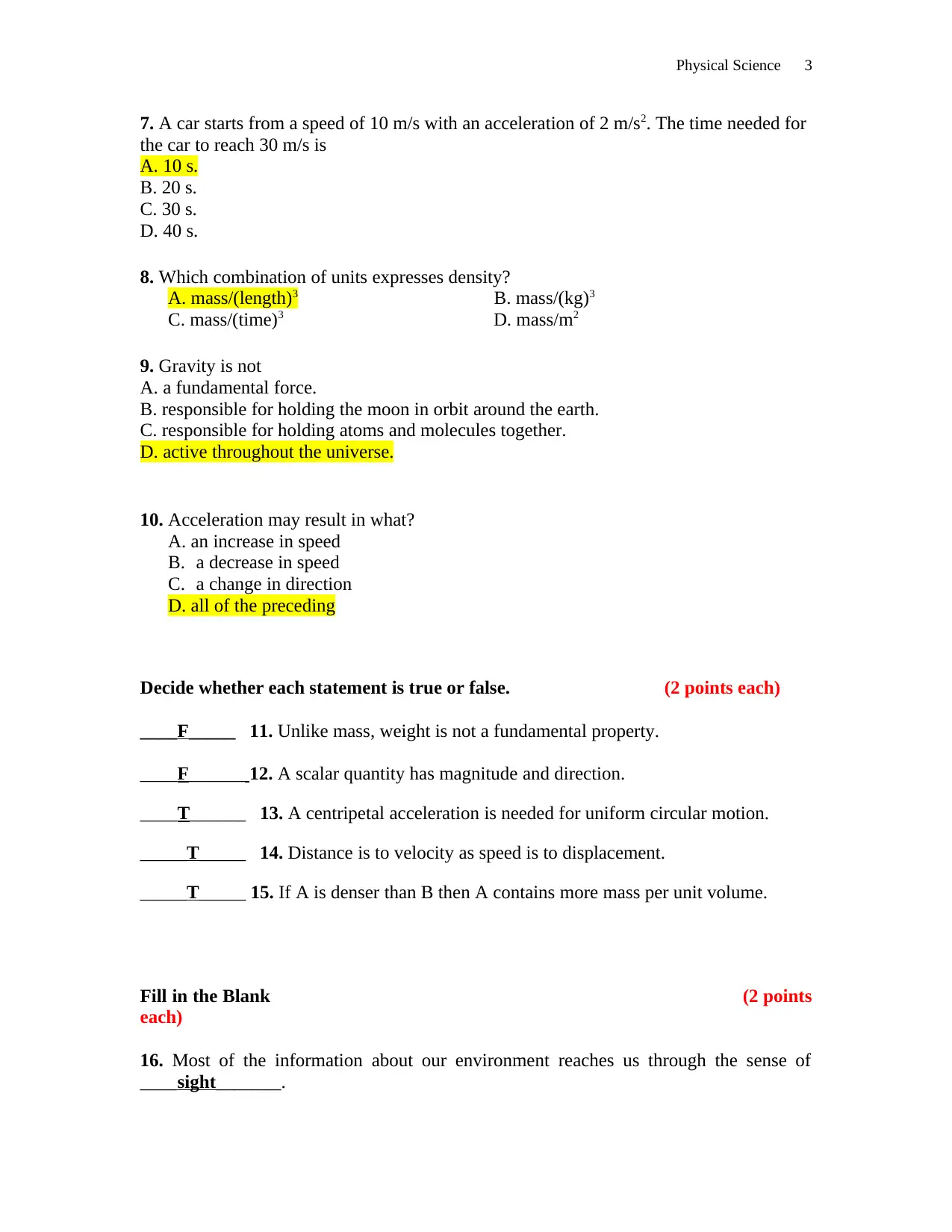
Physical Science 3
7. A car starts from a speed of 10 m/s with an acceleration of 2 m/s2. The time needed for
the car to reach 30 m/s is
A. 10 s.
B. 20 s.
C. 30 s.
D. 40 s.
8. Which combination of units expresses density?
A. mass/(length)3 B. mass/(kg)3
C. mass/(time)3 D. mass/m2
9. Gravity is not
A. a fundamental force.
B. responsible for holding the moon in orbit around the earth.
C. responsible for holding atoms and molecules together.
D. active throughout the universe.
10. Acceleration may result in what?
A. an increase in speed
B. a decrease in speed
C. a change in direction
D. all of the preceding
Decide whether each statement is true or false. (2 points each)
____F_____ 11. Unlike mass, weight is not a fundamental property.
____F______ 12. A scalar quantity has magnitude and direction.
____T______ 13. A centripetal acceleration is needed for uniform circular motion.
_____T_____ 14. Distance is to velocity as speed is to displacement.
_____T_____ 15. If A is denser than B then A contains more mass per unit volume.
Fill in the Blank (2 points
each)
16. Most of the information about our environment reaches us through the sense of
____sight_______.
7. A car starts from a speed of 10 m/s with an acceleration of 2 m/s2. The time needed for
the car to reach 30 m/s is
A. 10 s.
B. 20 s.
C. 30 s.
D. 40 s.
8. Which combination of units expresses density?
A. mass/(length)3 B. mass/(kg)3
C. mass/(time)3 D. mass/m2
9. Gravity is not
A. a fundamental force.
B. responsible for holding the moon in orbit around the earth.
C. responsible for holding atoms and molecules together.
D. active throughout the universe.
10. Acceleration may result in what?
A. an increase in speed
B. a decrease in speed
C. a change in direction
D. all of the preceding
Decide whether each statement is true or false. (2 points each)
____F_____ 11. Unlike mass, weight is not a fundamental property.
____F______ 12. A scalar quantity has magnitude and direction.
____T______ 13. A centripetal acceleration is needed for uniform circular motion.
_____T_____ 14. Distance is to velocity as speed is to displacement.
_____T_____ 15. If A is denser than B then A contains more mass per unit volume.
Fill in the Blank (2 points
each)
16. Most of the information about our environment reaches us through the sense of
____sight_______.
⊘ This is a preview!⊘
Do you want full access?
Subscribe today to unlock all pages.

Trusted by 1+ million students worldwide
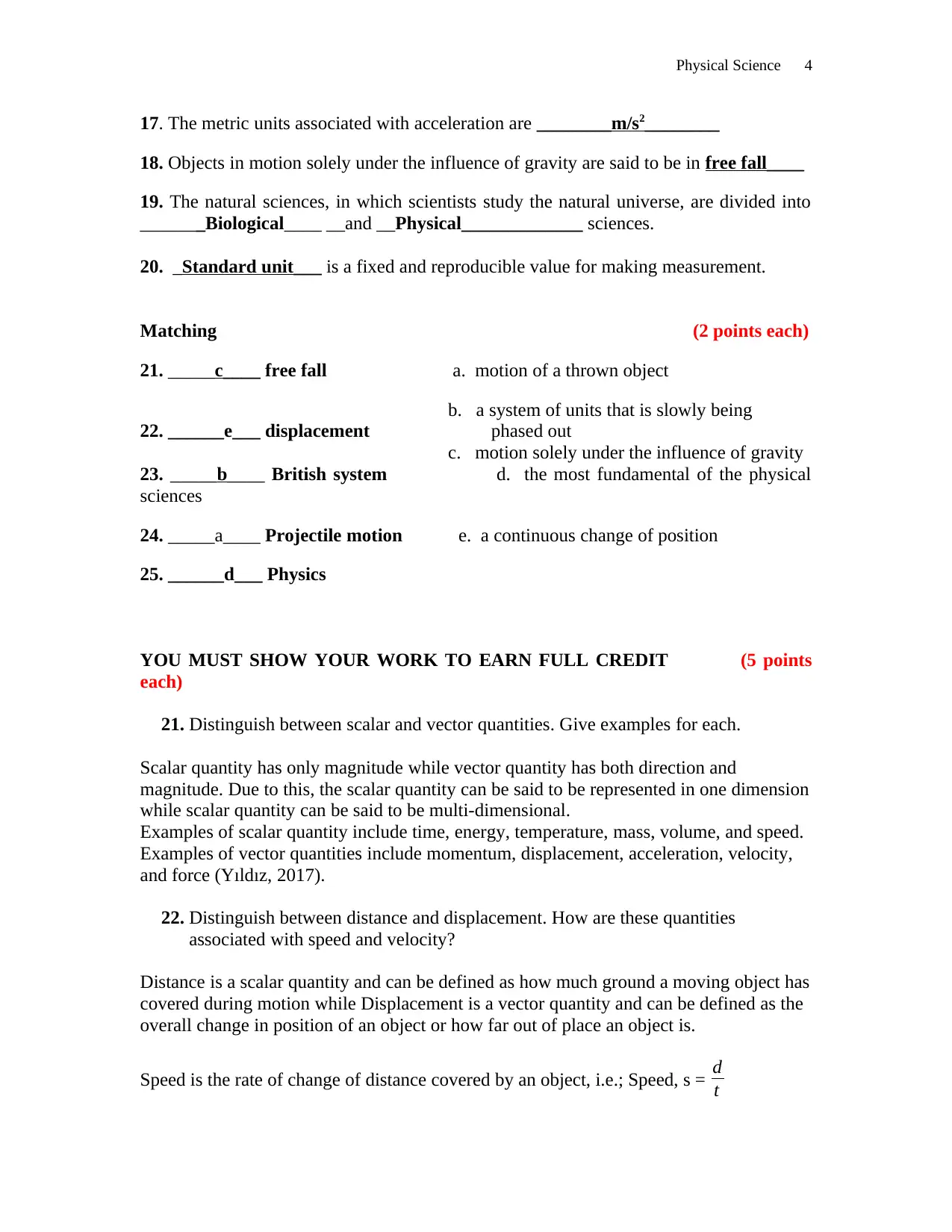
Physical Science 4
17. The metric units associated with acceleration are ________m/s2________
18. Objects in motion solely under the influence of gravity are said to be in free fall____
19. The natural sciences, in which scientists study the natural universe, are divided into
_______Biological____ __and __Physical_____________ sciences.
20. _Standard unit___ is a fixed and reproducible value for making measurement.
Matching (2 points each)
21. _____c____ free fall a. motion of a thrown object
b. a system of units that is slowly being
22. ______e___ displacement phased out
c. motion solely under the influence of gravity
23. _____b____ British system d. the most fundamental of the physical
sciences
24. _____a____ Projectile motion e. a continuous change of position
25. ______d___ Physics
YOU MUST SHOW YOUR WORK TO EARN FULL CREDIT (5 points
each)
21. Distinguish between scalar and vector quantities. Give examples for each.
Scalar quantity has only magnitude while vector quantity has both direction and
magnitude. Due to this, the scalar quantity can be said to be represented in one dimension
while scalar quantity can be said to be multi-dimensional.
Examples of scalar quantity include time, energy, temperature, mass, volume, and speed.
Examples of vector quantities include momentum, displacement, acceleration, velocity,
and force (Yıldız, 2017).
22. Distinguish between distance and displacement. How are these quantities
associated with speed and velocity?
Distance is a scalar quantity and can be defined as how much ground a moving object has
covered during motion while Displacement is a vector quantity and can be defined as the
overall change in position of an object or how far out of place an object is.
Speed is the rate of change of distance covered by an object, i.e.; Speed, s = d
t
17. The metric units associated with acceleration are ________m/s2________
18. Objects in motion solely under the influence of gravity are said to be in free fall____
19. The natural sciences, in which scientists study the natural universe, are divided into
_______Biological____ __and __Physical_____________ sciences.
20. _Standard unit___ is a fixed and reproducible value for making measurement.
Matching (2 points each)
21. _____c____ free fall a. motion of a thrown object
b. a system of units that is slowly being
22. ______e___ displacement phased out
c. motion solely under the influence of gravity
23. _____b____ British system d. the most fundamental of the physical
sciences
24. _____a____ Projectile motion e. a continuous change of position
25. ______d___ Physics
YOU MUST SHOW YOUR WORK TO EARN FULL CREDIT (5 points
each)
21. Distinguish between scalar and vector quantities. Give examples for each.
Scalar quantity has only magnitude while vector quantity has both direction and
magnitude. Due to this, the scalar quantity can be said to be represented in one dimension
while scalar quantity can be said to be multi-dimensional.
Examples of scalar quantity include time, energy, temperature, mass, volume, and speed.
Examples of vector quantities include momentum, displacement, acceleration, velocity,
and force (Yıldız, 2017).
22. Distinguish between distance and displacement. How are these quantities
associated with speed and velocity?
Distance is a scalar quantity and can be defined as how much ground a moving object has
covered during motion while Displacement is a vector quantity and can be defined as the
overall change in position of an object or how far out of place an object is.
Speed is the rate of change of distance covered by an object, i.e.; Speed, s = d
t
Paraphrase This Document
Need a fresh take? Get an instant paraphrase of this document with our AI Paraphraser
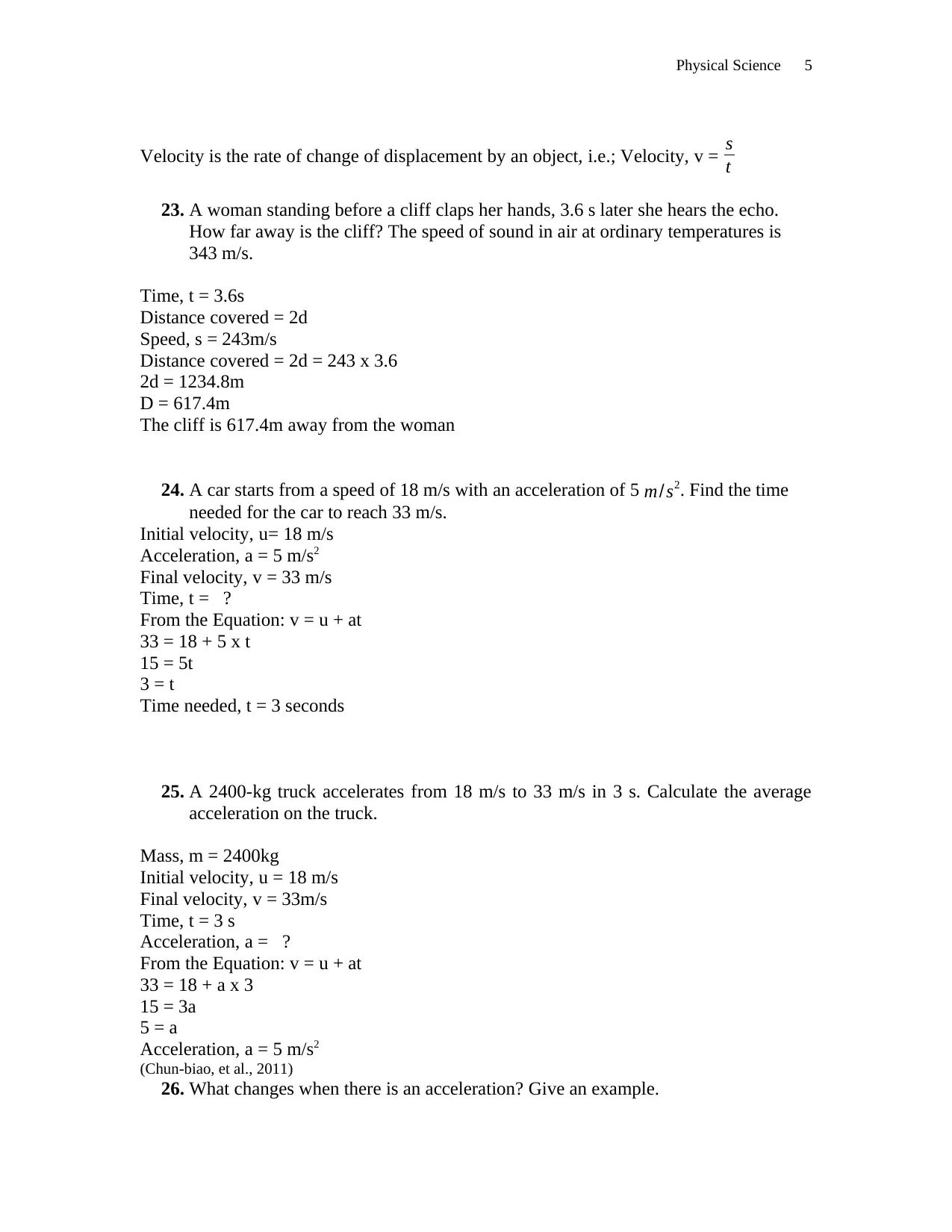
Physical Science 5
Velocity is the rate of change of displacement by an object, i.e.; Velocity, v = s
t
23. A woman standing before a cliff claps her hands, 3.6 s later she hears the echo.
How far away is the cliff? The speed of sound in air at ordinary temperatures is
343 m/s.
Time, t = 3.6s
Distance covered = 2d
Speed, s = 243m/s
Distance covered = 2d = 243 x 3.6
2d = 1234.8m
D = 617.4m
The cliff is 617.4m away from the woman
24. A car starts from a speed of 18 m/s with an acceleration of 5 m/s2. Find the time
needed for the car to reach 33 m/s.
Initial velocity, u= 18 m/s
Acceleration, a = 5 m/s2
Final velocity, v = 33 m/s
Time, t = ?
From the Equation: v = u + at
33 = 18 + 5 x t
15 = 5t
3 = t
Time needed, t = 3 seconds
25. A 2400-kg truck accelerates from 18 m/s to 33 m/s in 3 s. Calculate the average
acceleration on the truck.
Mass, m = 2400kg
Initial velocity, u = 18 m/s
Final velocity, v = 33m/s
Time, t = 3 s
Acceleration, a = ?
From the Equation: v = u + at
33 = 18 + a x 3
15 = 3a
5 = a
Acceleration, a = 5 m/s2
(Chun-biao, et al., 2011)
26. What changes when there is an acceleration? Give an example.
Velocity is the rate of change of displacement by an object, i.e.; Velocity, v = s
t
23. A woman standing before a cliff claps her hands, 3.6 s later she hears the echo.
How far away is the cliff? The speed of sound in air at ordinary temperatures is
343 m/s.
Time, t = 3.6s
Distance covered = 2d
Speed, s = 243m/s
Distance covered = 2d = 243 x 3.6
2d = 1234.8m
D = 617.4m
The cliff is 617.4m away from the woman
24. A car starts from a speed of 18 m/s with an acceleration of 5 m/s2. Find the time
needed for the car to reach 33 m/s.
Initial velocity, u= 18 m/s
Acceleration, a = 5 m/s2
Final velocity, v = 33 m/s
Time, t = ?
From the Equation: v = u + at
33 = 18 + 5 x t
15 = 5t
3 = t
Time needed, t = 3 seconds
25. A 2400-kg truck accelerates from 18 m/s to 33 m/s in 3 s. Calculate the average
acceleration on the truck.
Mass, m = 2400kg
Initial velocity, u = 18 m/s
Final velocity, v = 33m/s
Time, t = 3 s
Acceleration, a = ?
From the Equation: v = u + at
33 = 18 + a x 3
15 = 3a
5 = a
Acceleration, a = 5 m/s2
(Chun-biao, et al., 2011)
26. What changes when there is an acceleration? Give an example.
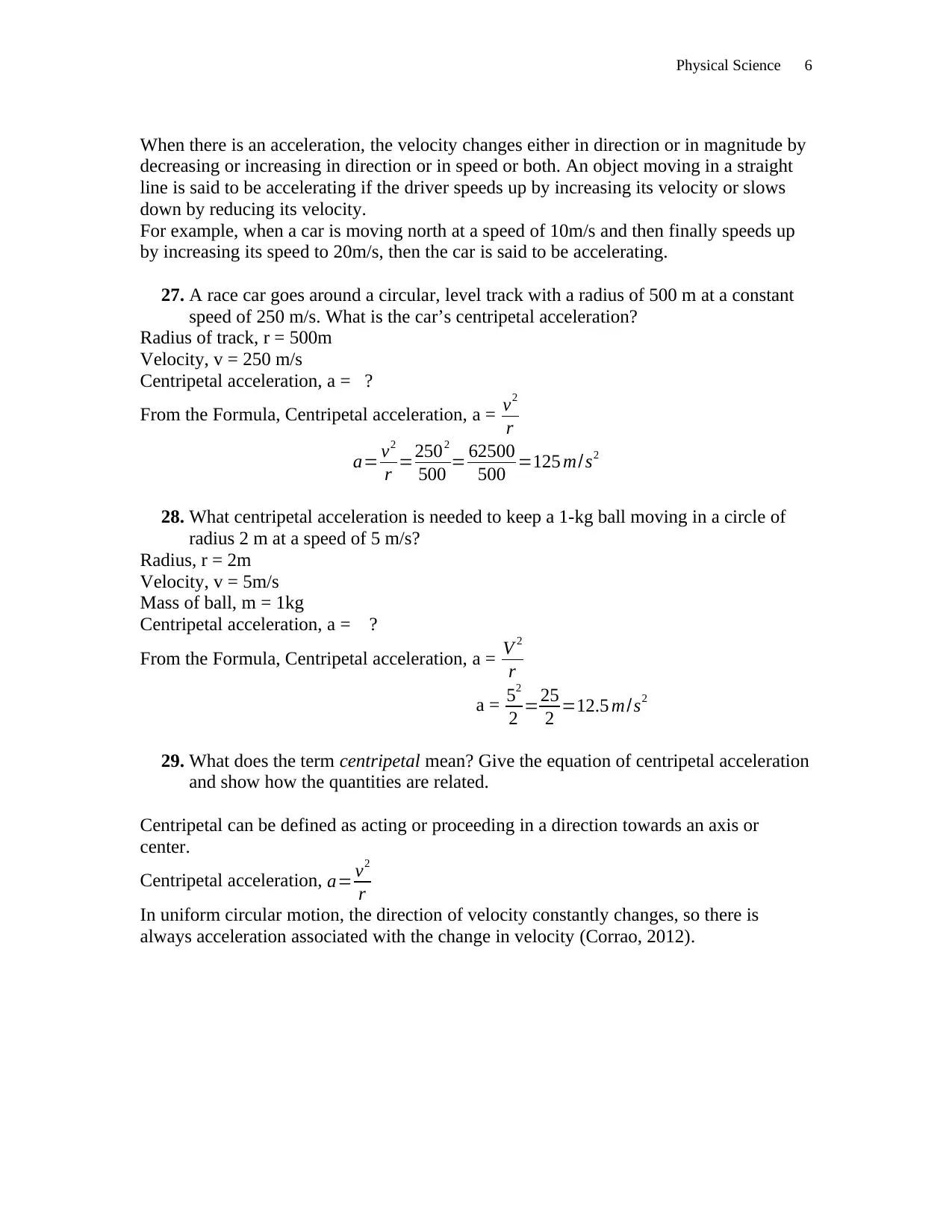
Physical Science 6
When there is an acceleration, the velocity changes either in direction or in magnitude by
decreasing or increasing in direction or in speed or both. An object moving in a straight
line is said to be accelerating if the driver speeds up by increasing its velocity or slows
down by reducing its velocity.
For example, when a car is moving north at a speed of 10m/s and then finally speeds up
by increasing its speed to 20m/s, then the car is said to be accelerating.
27. A race car goes around a circular, level track with a radius of 500 m at a constant
speed of 250 m/s. What is the car’s centripetal acceleration?
Radius of track, r = 500m
Velocity, v = 250 m/s
Centripetal acceleration, a = ?
From the Formula, Centripetal acceleration, a = v2
r
a= v2
r =2502
500 = 62500
500 =125 m/s2
28. What centripetal acceleration is needed to keep a 1-kg ball moving in a circle of
radius 2 m at a speed of 5 m/s?
Radius, r = 2m
Velocity, v = 5m/s
Mass of ball, m = 1kg
Centripetal acceleration, a = ?
From the Formula, Centripetal acceleration, a = V 2
r
a = 52
2 =25
2 =12.5 m/s2
29. What does the term centripetal mean? Give the equation of centripetal acceleration
and show how the quantities are related.
Centripetal can be defined as acting or proceeding in a direction towards an axis or
center.
Centripetal acceleration, a= v2
r
In uniform circular motion, the direction of velocity constantly changes, so there is
always acceleration associated with the change in velocity (Corrao, 2012).
When there is an acceleration, the velocity changes either in direction or in magnitude by
decreasing or increasing in direction or in speed or both. An object moving in a straight
line is said to be accelerating if the driver speeds up by increasing its velocity or slows
down by reducing its velocity.
For example, when a car is moving north at a speed of 10m/s and then finally speeds up
by increasing its speed to 20m/s, then the car is said to be accelerating.
27. A race car goes around a circular, level track with a radius of 500 m at a constant
speed of 250 m/s. What is the car’s centripetal acceleration?
Radius of track, r = 500m
Velocity, v = 250 m/s
Centripetal acceleration, a = ?
From the Formula, Centripetal acceleration, a = v2
r
a= v2
r =2502
500 = 62500
500 =125 m/s2
28. What centripetal acceleration is needed to keep a 1-kg ball moving in a circle of
radius 2 m at a speed of 5 m/s?
Radius, r = 2m
Velocity, v = 5m/s
Mass of ball, m = 1kg
Centripetal acceleration, a = ?
From the Formula, Centripetal acceleration, a = V 2
r
a = 52
2 =25
2 =12.5 m/s2
29. What does the term centripetal mean? Give the equation of centripetal acceleration
and show how the quantities are related.
Centripetal can be defined as acting or proceeding in a direction towards an axis or
center.
Centripetal acceleration, a= v2
r
In uniform circular motion, the direction of velocity constantly changes, so there is
always acceleration associated with the change in velocity (Corrao, 2012).
⊘ This is a preview!⊘
Do you want full access?
Subscribe today to unlock all pages.

Trusted by 1+ million students worldwide
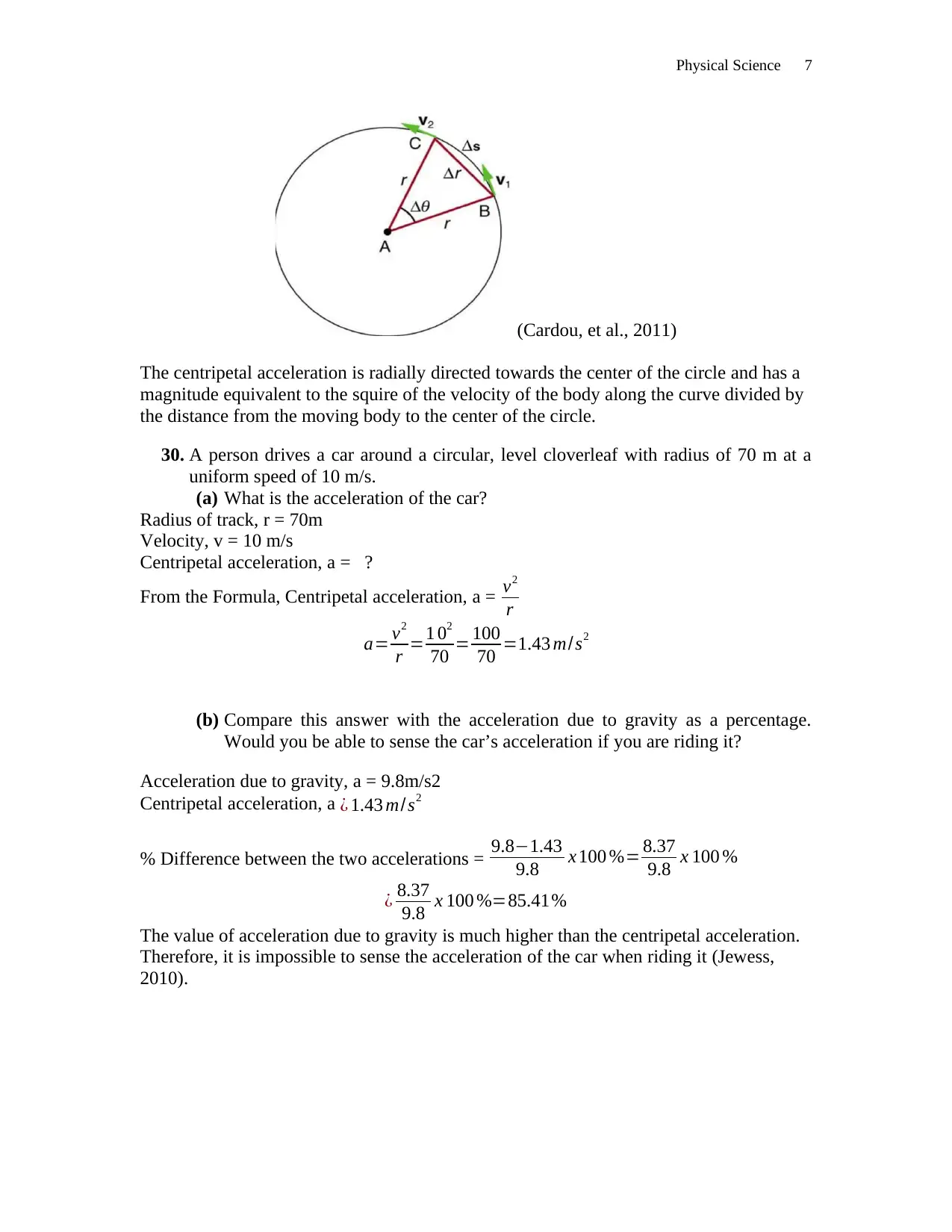
Physical Science 7
(Cardou, et al., 2011)
The centripetal acceleration is radially directed towards the center of the circle and has a
magnitude equivalent to the squire of the velocity of the body along the curve divided by
the distance from the moving body to the center of the circle.
30. A person drives a car around a circular, level cloverleaf with radius of 70 m at a
uniform speed of 10 m/s.
(a) What is the acceleration of the car?
Radius of track, r = 70m
Velocity, v = 10 m/s
Centripetal acceleration, a = ?
From the Formula, Centripetal acceleration, a = v2
r
a= v2
r =1 02
70 = 100
70 =1.43 m/ s2
(b) Compare this answer with the acceleration due to gravity as a percentage.
Would you be able to sense the car’s acceleration if you are riding it?
Acceleration due to gravity, a = 9.8m/s2
Centripetal acceleration, a ¿ 1.43 m/s2
% Difference between the two accelerations = 9.8−1.43
9.8 x 100 %= 8.37
9.8 x 100 %
¿ 8.37
9.8 x 100 %=85.41%
The value of acceleration due to gravity is much higher than the centripetal acceleration.
Therefore, it is impossible to sense the acceleration of the car when riding it (Jewess,
2010).
(Cardou, et al., 2011)
The centripetal acceleration is radially directed towards the center of the circle and has a
magnitude equivalent to the squire of the velocity of the body along the curve divided by
the distance from the moving body to the center of the circle.
30. A person drives a car around a circular, level cloverleaf with radius of 70 m at a
uniform speed of 10 m/s.
(a) What is the acceleration of the car?
Radius of track, r = 70m
Velocity, v = 10 m/s
Centripetal acceleration, a = ?
From the Formula, Centripetal acceleration, a = v2
r
a= v2
r =1 02
70 = 100
70 =1.43 m/ s2
(b) Compare this answer with the acceleration due to gravity as a percentage.
Would you be able to sense the car’s acceleration if you are riding it?
Acceleration due to gravity, a = 9.8m/s2
Centripetal acceleration, a ¿ 1.43 m/s2
% Difference between the two accelerations = 9.8−1.43
9.8 x 100 %= 8.37
9.8 x 100 %
¿ 8.37
9.8 x 100 %=85.41%
The value of acceleration due to gravity is much higher than the centripetal acceleration.
Therefore, it is impossible to sense the acceleration of the car when riding it (Jewess,
2010).
Paraphrase This Document
Need a fresh take? Get an instant paraphrase of this document with our AI Paraphraser
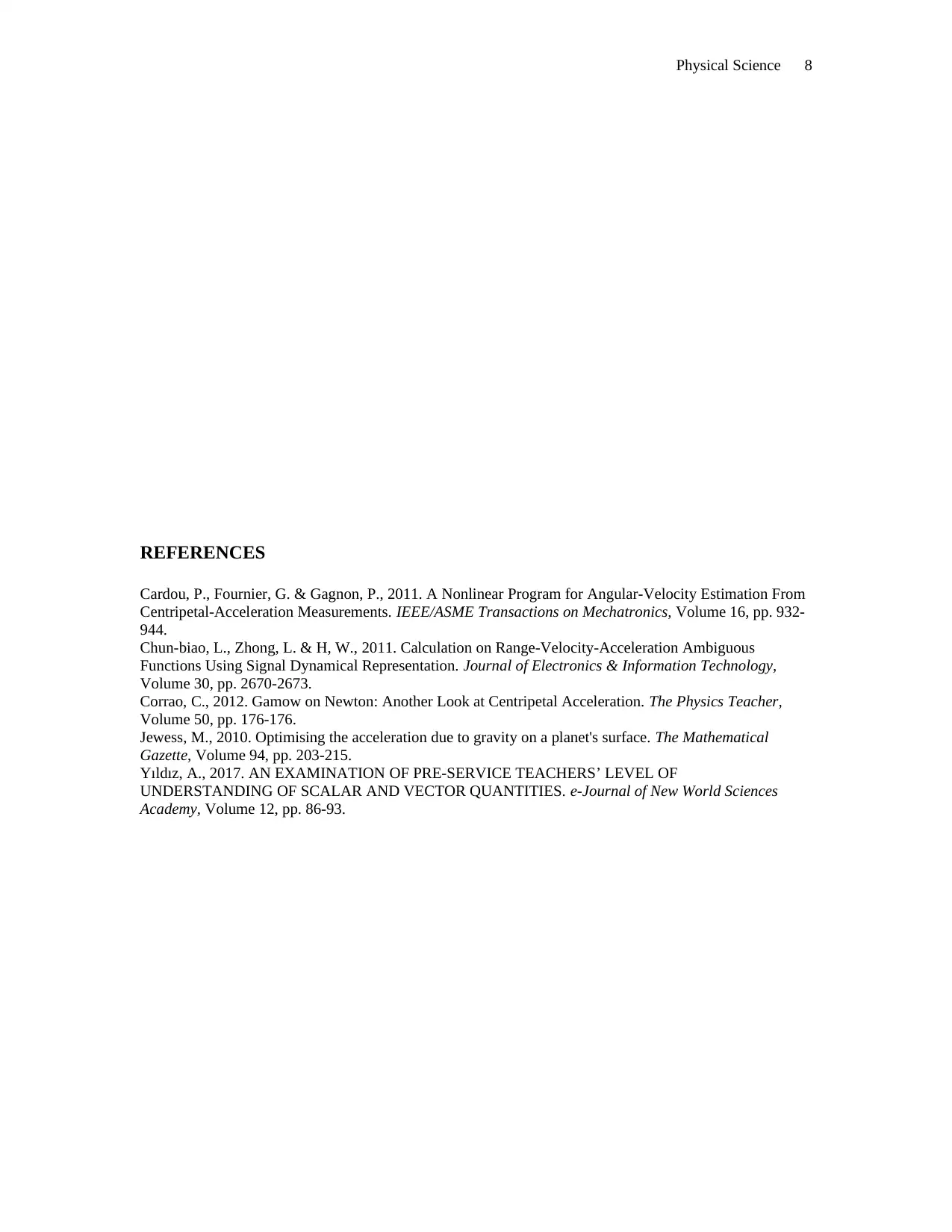
Physical Science 8
REFERENCES
Cardou, P., Fournier, G. & Gagnon, P., 2011. A Nonlinear Program for Angular-Velocity Estimation From
Centripetal-Acceleration Measurements. IEEE/ASME Transactions on Mechatronics, Volume 16, pp. 932-
944.
Chun-biao, L., Zhong, L. & H, W., 2011. Calculation on Range-Velocity-Acceleration Ambiguous
Functions Using Signal Dynamical Representation. Journal of Electronics & Information Technology,
Volume 30, pp. 2670-2673.
Corrao, C., 2012. Gamow on Newton: Another Look at Centripetal Acceleration. The Physics Teacher,
Volume 50, pp. 176-176.
Jewess, M., 2010. Optimising the acceleration due to gravity on a planet's surface. The Mathematical
Gazette, Volume 94, pp. 203-215.
Yıldız, A., 2017. AN EXAMINATION OF PRE-SERVICE TEACHERS’ LEVEL OF
UNDERSTANDING OF SCALAR AND VECTOR QUANTITIES. e-Journal of New World Sciences
Academy, Volume 12, pp. 86-93.
REFERENCES
Cardou, P., Fournier, G. & Gagnon, P., 2011. A Nonlinear Program for Angular-Velocity Estimation From
Centripetal-Acceleration Measurements. IEEE/ASME Transactions on Mechatronics, Volume 16, pp. 932-
944.
Chun-biao, L., Zhong, L. & H, W., 2011. Calculation on Range-Velocity-Acceleration Ambiguous
Functions Using Signal Dynamical Representation. Journal of Electronics & Information Technology,
Volume 30, pp. 2670-2673.
Corrao, C., 2012. Gamow on Newton: Another Look at Centripetal Acceleration. The Physics Teacher,
Volume 50, pp. 176-176.
Jewess, M., 2010. Optimising the acceleration due to gravity on a planet's surface. The Mathematical
Gazette, Volume 94, pp. 203-215.
Yıldız, A., 2017. AN EXAMINATION OF PRE-SERVICE TEACHERS’ LEVEL OF
UNDERSTANDING OF SCALAR AND VECTOR QUANTITIES. e-Journal of New World Sciences
Academy, Volume 12, pp. 86-93.
1 out of 8
Related Documents
Your All-in-One AI-Powered Toolkit for Academic Success.
+13062052269
info@desklib.com
Available 24*7 on WhatsApp / Email
![[object Object]](/_next/static/media/star-bottom.7253800d.svg)
Unlock your academic potential
Copyright © 2020–2025 A2Z Services. All Rights Reserved. Developed and managed by ZUCOL.




